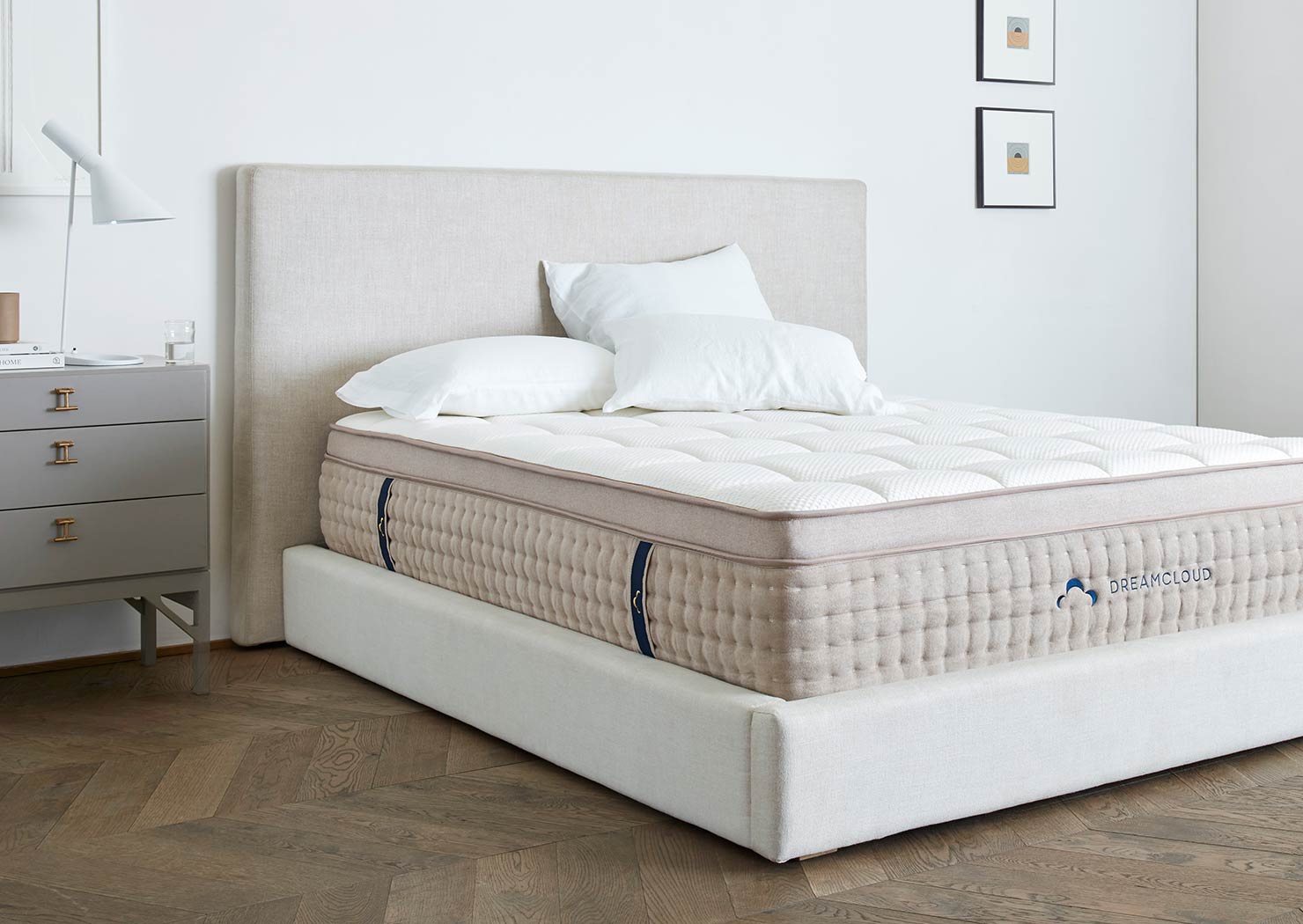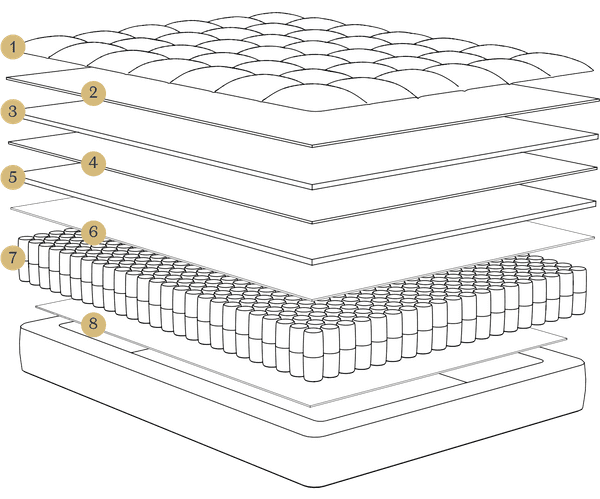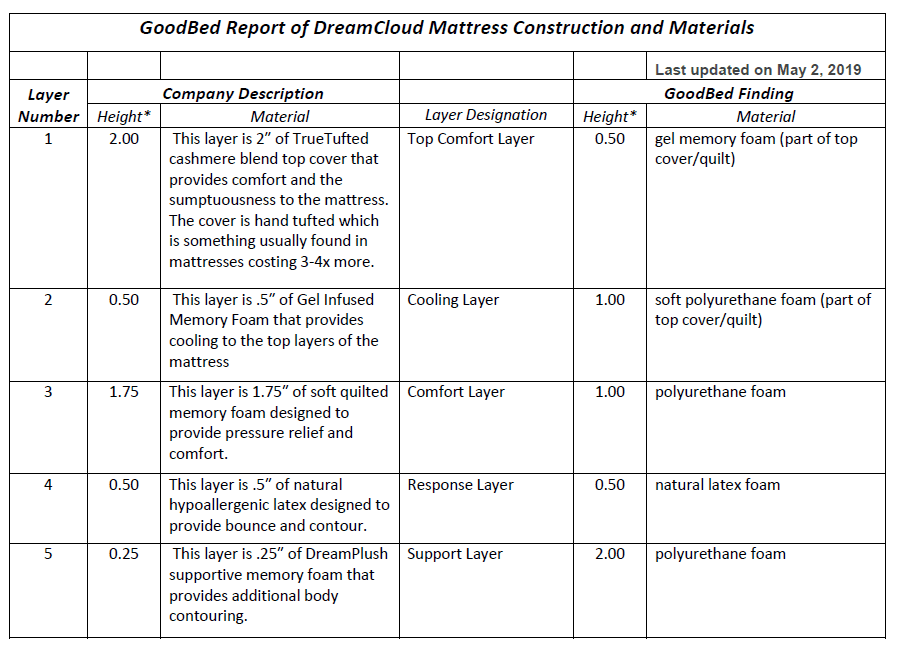
DreamCloud Mattress Review
DreamCloud Sleep, the high-end business unit of Resident (formly DreamCloud Holdings, LLC), says at the top of its website, “Affordable Luxury Starts With Sleep.” Packed into this short sentence are DreamCloud’s three primary mattress claims:
- This is a luxury mattress.
- It is affordable.
- It helps you sleep.
It also appeals to what health experts have been telling us for a long time: Sleep is essential to health.
In a sense, what DreamCloud is saying is the essence of what hundreds of mattress brands claim. Every mattress brand bills its products as contributing to restful sleep and better health. As with all mattresses, these claims have to be examined with the understanding that, like gloves, one mattress does not fit all. Most of the startups since 2014 aimed for the major middle with medium firm mattresses, 6-6.5 on a 10-point scale. Then, after getting a foothold in the market, they came out with softer and firmer offerings to broaden their market appeal.
Without specific details, DreamCloud Sleep says their mattress is “Backed by science to give you the deepest sleep possible.” They also have other statements, such as [emphasis my own]:
- “DreamCloud uses the [sic] innovative sleep science to guide our construction.”
- “Spend every night floating atop 15 inches of lovingly crafted, meticulously chosen, scientifically optimized sleep-enhancing luxury.”
- “DreamCloud uses the best natural latex combined with our patented coils and scientifically formulated memory foams for unbeatable comfort and luxurious support.”
Key Mattress Features
There are several key features which define the DreamCloud Mattress. These are cashmere, deep quilting, latex, pocket coils, and tufting.
Cashmere
DreamCloud’s claim to being a luxury mattress begins at the top. The cover fabric is a blend with cashmere. This wool-like hair of a breed of goats from Kashmir in India and Pakistan has long been considered a luxury fiber.
Deep Quilting
The cover of the DreamCloud is quilted, first with fibers, then with soft gel-infused memory foam. In the next two layers, describing one as “quilted” suggests interior quilting with two foam layers quilted together. However, this layer may be included in the quilting of the layer above with the cover.
Latex
This is called “natural hypoallergenic latex.” It is there to give some bounce from beneath the conforming memory foam. By FTC standards “natural” should mean that blended latex has a certain minimum percentage of liquid latex drawn from rubber trees. Almost 100% natural liquid latex makes it “all natural” latex, and “100% natural” should be just that – made with 100% natural liquid latex.
Pocket Coils
The DreamCloud Mattress is a foam/coil hybrid mattress. Like most hybrid mattresses, the support is pocket coils (also known as Marshall coils after their inventor). The chief benefit of these is their conformity, which provides pressure relief. This pressure relief is not as fine as that of memory foam, but 5½” of foam above smoothes it out. A secondary benefit is that pocket coils are better-suited to compressing and rolling a bed-in-a-box mattress than are other coil types.
Tufting
The DreamCloud Mattress is tufted all the way through, top-to-bottom. This is a feature of high-end luxury mattresses, such as those made by Hypnos and Aireloom. More than style, tufting keeps all the layers aligned, something critical to the integrity of a many-layer mattress which is compressed and rolled.
Mattress Construction
The DreamCloud Mattress, also called Plush Life by the company, consists of eight layers totaling 15” in height. It is a hybrid mattress with an 8” innerspring support core.

(1) Top Comfort Layer
The quilted cover is the top layer. The company lists it as a 2” thick pillow top (or Euro-top). Two inches thick may sound incredible, but this is a blended fabric of cashmere and polyester. Photos show it with a very high loft, suggesting two sheets of the fabric which may have fibers quilted between them.
(2) Cooling Layer
The cooling layer of the DreamCloud mattress is ½” of soft gel memory foam. This is included in the cover. Soft, low-density memory foam is not as heat sensitive as the more supportive densities, meaning it does not as readily accumulate heat. With the infused gel and the perforations from the diamond pattern quilting, is has a cooling function.
(3) Comfort Layer
This is described as “soft quilted memory foam” with a 1¾” height.
(4) Response Layer
The Response Layer is latex (formerly known as foam rubber). DreamCloud Sleep says it provides both bounce and contouring. However, it is only ½” thick, meaning it can’t provide much of either other than tempering the memory foam.
(5) Support Layer
This, according to the company, is another layer of memory foam. The company says it “provides additional body contouring,” which can’t be much since it is only ¼” high.
(6) Transition Layer
The role of a transition layer is to ease the user into the firmer support core. This is, according to the company, “high density supportive memory foam.”
(7) Support Core
The 8” high support core has 7” of steel pocket coils. This is accounted for by a half-inch insulator pad above and another below – insulators keep foam layers from getting into the coils and vice versa. DreamCloud Sleep describes them as “micro coils,” which wouldn’t fit 7” coils. The conventional use of the term “microcoils” is for coils no more than 4” high. However, one description mentions “5-zone layers” in the support core. A line drawing on the DreamCloud website of the mattress layers shows two layers in a coil-on-coil configuration. This makes the coils 3½” high, and therefore micro coils.
The coils in the DreamCloud Mattress are arranged into five zones of lighter (12.5 ga.) and heavier (2.0 ga.) wire. These zones are for more support under the heavier parts of the body.
(8) Base Foundation Layer
Underneath the pocket coil support unit is a 1½” base pad – what DreamCloud calls the Base Foundation Layer. DreamCloud says it is high density super soft memory foam. The purpose of base pads under pocket coils is to support the coils. They are not tied together, so the coils need to rest on something firm enough so they can respond to the weight of the sleeper. I a real sense, then, the Base Foundation Layer supports the mattress and those who sleep on it.
A Different Finding
DreamCloud Sleep has supplied mattresses to several independent reviewers to test and review. Almost all of them list the same materials n the layers as the company, and the heights are the same or almost the same. However, one reviewer does not have exactly the same list.
Michael Magnuson reviewed the DreamCloud Mattress for GoodBed, both in writing and on a video. Speaking for the GoodBed staff who inspected the mattress, he said that they “were impressed with the quality of materials and build quality of this Chinese-made bed.” After commending the full tufting, he went on to tell what they found when they got inside the mattress.
DreamCloud Sleep names memory foam as the material in five of its eight layers, but the GoodBed investigators say that only one layer, the second, was memory foam. The other four layers were “standard” polyurethane foam. Additionally, the heights of several layers differed significantly.
Some of the other reviewers, such as Sleepopolis, opened up the mattress, even photographed it to show us the materials. It is enough to make one wonder if the plant in China sometimes substitutes materials to meet production schedules. This is one of the risks of offshore contract production in a place where 15 years ago melamine had been used to fudge testing for protein in food products.
Marketing
Unlike the Nectar Mattress, which is sold on Amazon and in its Nectar Sleep X Brandbox store at Tyson’s Corner Center, DreamCloud Sleep sells it mattress only from its website.
Sleep Trial and Warranty
The DreamCloud Mattress has the same 365-Night Trial and Everlong Warranty as the Nectar Mattress.
Evaluation
The DreamCloud Mattress has an appealing design for a luxury hybrid mattress with coil-on-coil micro pocket coil support and foam layers comprising 40% of the mattress height. Some of the memory foam layers seem too thin to be effective individually, but together the effect is cumulative, even more so with the top-to-bottom tufting.
As far as cooling is concerned, the company’s descriptions credit this to gel infusion. From another perspective, this may be enhanced by the perforations of quilting and tufting. These would not be as effective as a whole-mattress configuration, such as Selectabed’s Airflow Transfer System or TEMPUR-Pedic’s Breeze Technology, but there have been few complaints about excess heat.
Customer Response
We calculate our ratings in accordance with our Verified Review Policy.
There are only two places where we find reviews by customers of the DreamCloud Mattress, the DreamCloud Sleep website and GoodBed. If these were sold on Amazon, we would also have reviews from their customers.
On DreamCloud Sleep
It is hard to get a fair picture of customer response on the DreamCloud Sleep site. On the top of the reviews page, it shows an average 4.5-star rating out of 1,603 reviews. There can be no more than 1,403 5-star review (that is if all the rest were 1-star ratings). The number of 5-star reviews is probably closer to 1,300. With 10 reviews per page, that is a maximum of 130 to 140 pages of 5-star ratings, leaving another 21 to 31 pages. Realistically, some pages will have more than one rating if these were sorted only by date. This means that on the average one of every ten pages should have some ratings of 4 stars or less. However, the first 25 pages of reviews are nothing but 5-star reviews.
On GoodBed
123 owners of DreamCloud mattresses left ratings on GoodBed. The greatest number of ratings are for 3 stars, followed by 26 2-star ratings. The average rating is 2.55 (51.06%).

Kudos & Complaints
There are 10 written reviews on GoodBed by owners of the DreamCloud Mattress. Of these, six rated the mattress at 5 stars, two at 4 stars, and one each at 3 stars and 1 star. The reviewer who had the bed the longest (6-12 months) said it was “some of the best sleep I’ve ever had.” This was echoed by another owner who had her bed about half as long.
A couple with physical problems said the quality was “exceptional,” but it was not the right fit for them – too firm. They praised customer service. Another 5-star review also praised customer service. However, customer service was one of the complaints by the reviewer who rated it 1 star.
A 4–star review said it took more than ten days to gas-off. Another reviewer stopped “tossing and turning” in bed. As is expected of a mattress with an “average” firmness, it was a bit too firm for some, and a bit too soft for others, and one said the balance of support and comfort was right. The most common complaint is about edge support – not firm enough.
Most of the complaints in the 1-star review concerned the mattress coming from China. This was not only about the mattress itself, but about shipments – not all items came when they should have, and some didn’t make it.

